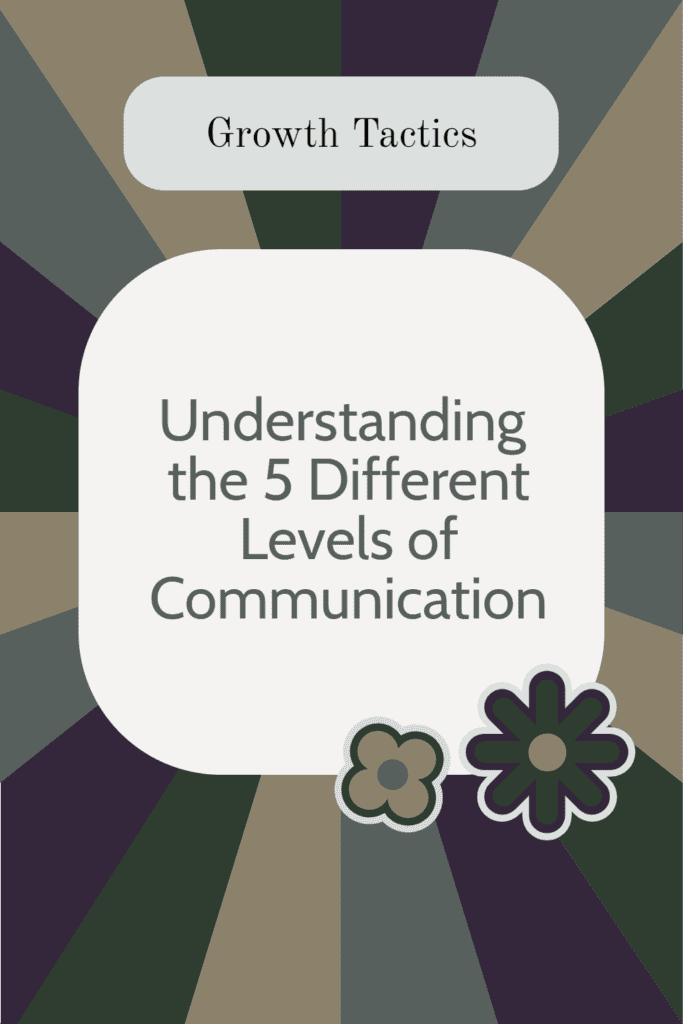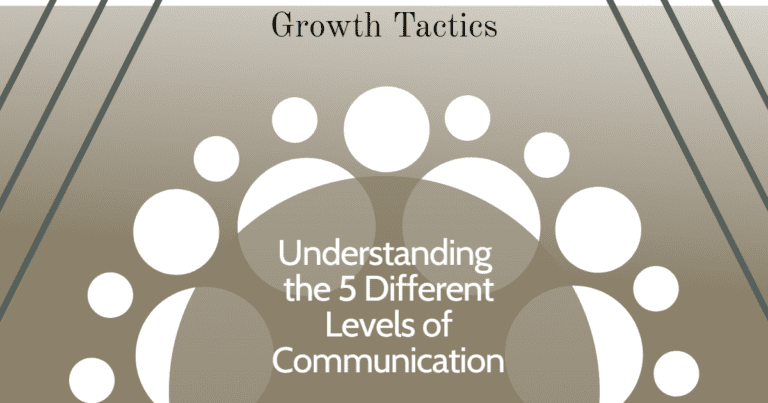Communication is the foundation of our personal relationships, both personal and professional. It is the key that unlocks understanding, connection, and growth.
However, communication goes beyond mere words and phrases. It is a complex process that involves various levels and layers.
Today, we will discuss the different levels of communication and explore how they impact our daily interactions. Are you ready? Let’s jump right in!
Jump To Section
Definition of Communication
Before we explore the different levels of communication, it’s important to learn what communication truly is. Communication is the art of exchanging information, ideas, and emotions. It involves not only verbal words but also non-verbal cues such as body language, facial expressions, and tone of voice.

Level 1: Surface-Level Communication
Surface-level communication is something we engage in every day, often without even realizing it. It is the small talk, the casual conversations, and the generic exchanges we have with acquaintances and strangers. While this level may seem trivial, it serves a purpose in establishing initial connections and social niceties. However, surface-level communication is limited in its depth and understanding. It’s like skimming the surface of a vast ocean without truly exploring the treasures it holds beneath.
Imagine Bob, a colleague of yours, who asks, “How was your weekend?” and you reply, “It was alright, thanks.” This exchange barely scratches the surface, conveying little information about your experiences and emotions. It maintains a polite distance, keeping the conversation light and superficial.

Level 2: Personal Level Communication
As we move deeper into the layers of communication, we encounter the personal level. This level involves sharing our thoughts, feelings, and experiences with others in a more meaningful way. It requires vulnerability, trust, and a willingness to open up. Personal level communication allows us to build deeper connections and cultivate strong bonds with our loved ones.
Think of Sarah, your closest friend, with whom you share your deepest fears, dreams, and challenges. In these conversations, you let go of pretenses and allow Sarah to see your true self. This level of communication is where true understanding and empathy flourish, fostering meaningful relationships.

Level 3: Professional Level Communication
In the realm of work and business, professional level communication becomes paramount. This level is characterized by clear, concise, and respectful exchanges of information in a professional setting. It encompasses both written communication, such as emails and reports, as well as verbal exchanges during meetings and presentations.
Professional level communication requires us to express ourselves with clarity and professionalism. It demands attention to detail, appropriate tone, and timely responses. Our ability to effectively communicate on this level can greatly impact our career success and how our colleagues perceive us.

Level 4: Emotional Level Communication
At the emotional level of communication, we dive into the depths of our feelings and emotions. It is at this level that we explore our own emotional landscape and empathize with others. Emotional level communication allows us to connect on a profound level, fostering understanding and support during conflicts, challenges, and moments of joy.
Suppose you and your partner, Mark, are having a disagreement. Emotional level communication allows you to express your feelings, listen to Mark’s perspective with empathy, and work together to find a solution. By acknowledging and understanding each other’s emotions, you can navigate conflicts with grace and foster a stronger connection.

Level 5: Meta-Level Communication
As we ascend to the final level of communication, we reach the meta-level. Meta-level communication involves reflecting upon and discussing the very process of communication itself. It is the ability to give and receive feedback, actively listen, and adapt our communication style to better connect with others.
Consider a situation in which you and your team are working on a project. During a brainstorming session, meta-level communication allows you to actively listen to your team members, provide constructive feedback, and adapt your style to ensure everyone’s voice is heard. By engaging in meta-level communication, you create an environment that encourages growth, collaboration, and innovation.
How Do We Develop Meta-Level Communication?
Developing self-awareness is a crucial step in mastering meta-communication. When we understand our own patterns, beliefs, and assumptions, we can better manage and align our meta-messages with our explicit messages. Reflect on your communication style, seek feedback, and practice mindfulness.
Mastering Meta-Listening
Now that we understand the importance of meta-messages, let’s explore how we can become masterful meta-listeners. Active listening is the key to hearing beyond words and understanding the meta-messages behind them. This involves techniques such as paraphrasing, summarizing, and asking clarifying questions.
Paraphrasing is a powerful listening tool. It involves restating what the speaker has said in your own words, showing that you’ve truly understood their message. Summarizing takes this a step further, capturing the main points of the conversation to ensure alignment and clarity. Asking clarifying questions helps fill in any gaps and shows your genuine interest in understanding the speaker’s perspective.
But active listening goes beyond words alone. Nonverbal cues can often reveal the true emotions and intentions behind someone’s message. Pay attention to body language, facial expressions, and tone of voice. These signals can provide valuable insights into the unsaid, helping you navigate the complex world of meta-communication like a pro.
Expressing Meta-Messages with Impact
To effectively express meta-messages, we must tap into our emotional intelligence. Emotional intelligence is a powerful asset in interpersonal communication. Emotional intelligence involves understanding and managing our emotions and empathizing with others. When we harness our emotional intelligence, we can communicate our meta-messages with impact and connection.
Begin by honing your empathy. Put yourself in others’ shoes and try to understand their perspective. Practicing active empathy allows you to not only listen to their words but also to connect with their emotions and unspoken intentions.
Crafting inclusive and constructive meta-messages is another essential skill. Consider the cultural nuances and individual differences at play and choose your words carefully. By expressing your meta-messages in a way that resonates with others, you’ll foster understanding and encourage open dialogue.

Navigating Conflict with Meta-Communication
Conflicts are an inevitable part of life, but with meta-communication as your ally, you can navigate them with grace and a collaborative mindset. Recognizing conflict patterns is the first step. As you become attuned to the meta-messages interwoven within conflicts, you gain greater insight into their underlying causes and can work toward resolution.
Applying meta-level communication strategies during conflicts is essential. Reframing the situation allows you to see it from a new perspective, opening up possibilities for resolution. Perspective-taking enables you to empathize with the other person and understand their motivations, cultivating empathy and connection. Active listening plays a crucial role here, helping you truly hear and understand each other’s concerns.
Managing emotions is vital in conflict resolution. By keeping emotions in check and maintaining a collaborative mindset, you can create an environment of trust and openness. Remember, conflicts are opportunities for growth and understanding.
Integrating the Levels for Comprehensive Communication
To harness the full potential of these communication levels, you should:
Identify the Level Needed
Assess the context and purpose of your interaction. This means understanding what the situation calls for and who you’re talking to.
If it’s a new acquaintance, surface-level communication works best. But, if you’re discussing a project with a colleague, you’ll need to move to a professional level. And when supporting a friend in need, emotional level communication is key.
Adapt your approach to fit the moment and the individual. Personalize your communication to make it meaningful.
Practice Active Listening
Active listening is essential at any communication level. It’s more than hearing words it’s understanding the whole message.
Pay attention to what is said and how it’s said. Look at body language, facial expressions, and tone of voice. Nod your head, make eye contact, and occasionally paraphrase what you’ve heard to show that you’re engaged.
Active listening helps you connect deeply with others and shows them that you value their input.
Seek Feedback
Be open to receiving feedback about your communication style. This isn’t always easy, but it’s crucial for growth. Ask trusted colleagues, friends, or family members for their honest opinions.
How can you improve? What are you doing well?
Use this information to adjust and become more effective. Remember, constructive criticism is an opportunity to learn and develop better communication habits.
Reflect and Adjust
After any significant interaction, take a moment to reflect. What went well? What could have been better? This reflection isn’t about self-criticism; it’s about growth. Write down your thoughts or discuss them with a mentor. Use these insights to fine-tune your communication skills continually.
Every interaction is a chance to learn. By understanding and applying these levels of communication, you shape better, more meaningful connections. This thoughtful approach will lead to stronger relationships and greater personal and professional success.
Types of Communication: Interpersonal and Intrapersonal

Interpersonal and intrapersonal communication represent two fundamental types of communication that shape our interactions and self-awareness.
Effective interpersonal communication occurs between individuals, serving as a bridge that fosters understanding, connection, and collaboration. It includes verbal exchanges, non-verbal cues, and active listening, allowing us to express thoughts and emotions while also understanding the perspectives of others.
Whether it’s a heart-to-heart conversation with a friend or a brainstorming session with colleagues, interpersonal communication skills are in building relationships and enhancing teamwork.
On the other hand, intrapersonal communication takes place within ourselves. It encompasses our internal dialogues, thoughts, and reflections. This type of communication aids in self-analysis, decision-making, and emotional regulation. Understanding our own feelings and motivations through intrapersonal communication is crucial for personal growth and emotional intelligence.
By honing both interpersonal and intrapersonal communication skills, we can navigate our social landscapes with greater ease and depth, paving the way for meaningful interactions and enriched lives.

Tips for Organizational Communication
Effective communication abilities are the heart of any successful organization. It is the key that unlocks collaboration, productivity, and harmony among team members.
In fact, research shows that companies with effective communication practices are 50% more likely to have lower employee turnover. Communication breakdowns, on the other hand, contribute to misunderstandings, conflicts, and decreased productivity.
If you want to create a work environment that thrives on open and efficient communication, here are five essential tips for organizing communication:
1. Establish Open Lines of Communication
One of the first steps toward effective organizational communication is establishing open lines of communication. This means creating an environment at different levels of management where team members feel comfortable expressing their thoughts, concerns, and ideas without fear of judgment or reprisal. Encourage the use of multiple communication channels, such as email, instant messaging, and face-to-face conversations.
When team members have various communication options, they can choose the method that suits their needs and preferences at any given moment. Some individuals may prefer face-to-face conversations for complex discussions, while others may find written communication more effective for certain tasks.
Moreover, fostering an environment that values transparency and honesty is crucial for establishing open lines of communication. Team members should feel encouraged to share their opinions and concerns openly, knowing that their input is valued and respected. When everyone feels heard, it leads to improved teamwork, trust, and collaboration among team members.
2. Active Listening
Communication is a two-way street. It’s not just about expressing yourself; it’s equally important to listen actively to others. Active listening involves fully engaging with the speaker and understanding their message, not just hearing the words they say. By actively listening, you show respect and consideration for others’ perspectives and increase mutual understanding.
To practice active listening, maintain eye contact with the speaker to show that you are fully present and attentive. Nodding occasionally and using appropriate facial expressions and gestures demonstrate that you are actively engaged in the conversation. Additionally, asking clarifying questions can help you gain a better understanding of the speaker’s message and ensure there are no misunderstandings.
Remember, active listening extends beyond verbal communication. Pay attention to non-verbal cues like body language and tone of voice. These can often provide valuable insights into the speaker’s emotions and help you to better understand the underlying message.
3. Clear and Concise Communication
Clarity is the cornerstone of effective communication. When conveying information, it’s essential to use clear and straightforward language that is easily understood by all parties involved. Avoid using jargon or technical terms that may be unfamiliar to some. Keep your message concise and to the point, focusing on the most important details.
Before communicating, take a moment to organize your thoughts. Consider the key points you want to convey and structure your message accordingly. For written communication, using bullet points or headings can help break up information and make it easier to digest.
Remember, clear and concise communication reduces the risk of misunderstandings. When your message is concise and well-structured, there is less chance of misinterpretation or confusion. It ensures that your message is accurately received and understood by your intended audience.

4. Utilize Technology Tools
Rapid advancements in technology have opened up new possibilities for enhancing organizational communication. A wide range of technology tools are available to streamline communication processes and improve efficiency for both one-on-one and group communication.
One such tool is project management software. These platforms allow teams to collaborate on projects, share files, and track progress all in one place. They provide visibility into project timelines, deadlines, and assigned tasks, helping team members stay organized and informed.
Video conferencing tools have also become essential for communication, especially for remote or distributed teams. They enable face-to-face communication, even when team members are physically apart. Video conferencing helps to build stronger connections, as facial expressions and body language are clearly visible, creating a more personal and engaging experience.
Collaborative platforms, such as productivity suites or project management tools, allow team members to work together, share ideas, and provide real-time feedback. These platforms foster collaboration and eliminate the need for lengthy email chains or time-consuming meetings.
When selecting technology tools, consider your organization’s specific needs and requirements. Choose tools that integrate well with existing systems and provide the necessary features to support your communication goals.
5. Foster a Feedback Culture
Constructive feedback is a powerful tool for improving organizational communication. It helps individuals grow, develop their skills, and align their actions with organizational goals. By fostering a feedback culture, you create an atmosphere where feedback is not only welcomed but actively encouraged.
Regular, effective feedback sessions should be part of your communication strategy. These sessions provide an opportunity for team members to share their thoughts, concerns, and suggestions openly. When giving feedback, focus on specific behaviors or actions rather than attacking personal characteristics. Provide concrete examples and actionable suggestions for improvement.
A feedback culture leads to increased employee engagement and satisfaction. When team members feel their opinions are valued and that they have a say in the decision-making process, they are more likely to be committed and motivated.
Final Thoughts on the 5 Levels of Communication
Understanding the different levels of communication is like unlocking the layers of a beautiful painting. Each level presents an opportunity to deepen our connections, create understanding, and foster growth. By recognizing the importance of each level and developing our communication skills accordingly, we can transform our relationships and achieve success in various areas of our lives.
So, my friends, let us embark on this journey of communication mastery. Let us dive beneath the surface, open our hearts, and embrace the power of effective communication at each level. By doing so, we will forge meaningful connections, nurture our relationships, and create a life of fulfillment and impact.


